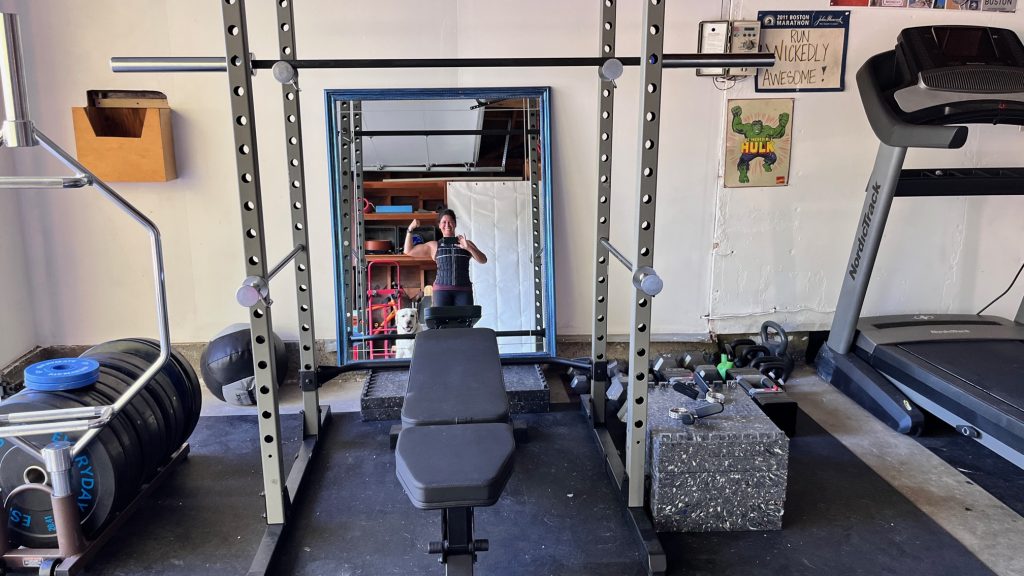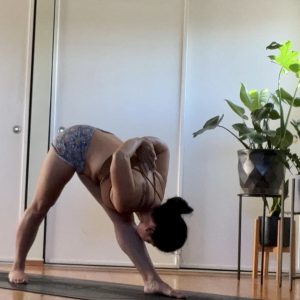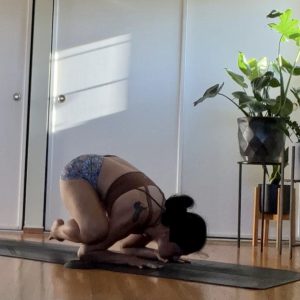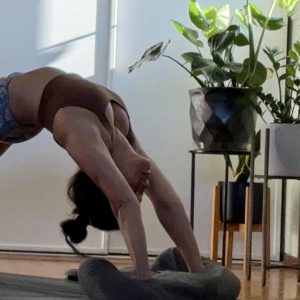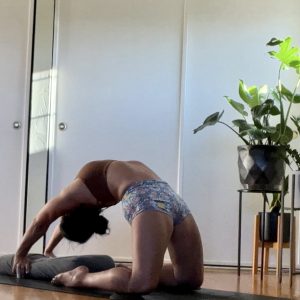non-judgement
The Joy of Acknowledgement
Have you ever noticed how easy it is to see someone else’s progress but how hard it is to recognize your own? As a yoga teacher, I always try to point out the progress I see my students making. It may be something as subtle as a deeper but more relaxed breath — which translates to huge strides down the road. Possibly, it is something more obvious, like being able to balance on their hands in one of the many arm balancing poses.
Believe it or not, the students don’t always seem to acknowledge the progress no matter how obvious it may be. Sometimes, I take a photo to show them the progress I am observing. I did this for one our mysore students this week, pointing out the lovely lines in her trikonasana and utthita parsvokonasana. If they do finally achieve a goal – such as finally getting their foot behind their head in eka pada sirsasana – they are disappointed that they have to hold it in place or it flies off like it’s spring-loaded.
Quite honestly, I am guilty of this myself. Over the last year, my practice has suffered from a number of compounding ailments including finger fractures and shoulder instablity. My focus has been on the struggle to improve but without a lot of notice taken on the steps forward, only the backward shifts that naturally occur in the effort.
Like this new leaf on my monstera plant, new growth is beautiful. Sometimes, these new leaves go unnoticed for a bit as they hide behind the others. But, oh how I love to welcome the newbies into my practice space. They really make me smile.
Back to the topic of yoga: Although somewhat unconsciously, my efforts in not becoming attached to any success have translated to blindfolding me to any progress made in this regard. I think I feared (or maybe expected) that I would lose it again in the next days, weeks, or months. There’s been a lot of that.
In the beginning, this may have been thought to be non-attachment but I now think that the failure to celebrate the successes has lead to less joy in my yoga practice. And I really need JOY right now. I mean, in addition to the joy of seeing new leaves on my plants.
For this reason, I plan to resurect the habit of daily entries in my yoga journal in the month of May with a focus on listing out some wins each day. In the past, regular journalling about my yoga practice has served as a nice way to highlight emerging injuries and track them back seemingly subtle to modifications or added poses. This month, I hope to be able to pay a bit more attention to little steps of progress as well as the coming and going of poses as I continue to work on healing from the injuries of the past year. Currently, I am calling this exercise the Joy of Acknowledgement.
I invite you to do the same and/or share your thoughts in the comments section of this post.
$h!t Happens!
We’d like to think that, after years of practicing this thing called yoga (and life), we would be able to avoid all injuries. However, the truth is, you can be ever so mindful and careful, but injuries still happen. You don’t even have to be doing anything intense. In fact, you might simply be rearranging things in your garage. *sigh*
It’s true. We are in the process of building a sweet home-based gym in our garage. My youngest has been making most of the purchases; I have mostly been contributing by providing him with the space to keep it. But, as the equipment has arrived, I have found it rather convenient to workout here at home. In doing so, I save a travel time and time at the gym waiting for the space, specific dumbbell or machine to free up. So, I began contributing by purchasing needed items myself.
It’s not as easy as one might think. My son said we needed some “DC blocks” so I purchased 2 of them to get us started. When they arrived, I realized the ones I’d bought were extra wide and not returnable. My second purchase was padded flooring. After many out of stock, backordered choices delaying this purchase, I finally landed on mat flooring that was in stock and soon delivered.
It was the day that we unrolled our gym flooring when my injury occurred. Being the independent (read: impatient) person that I am, I did most of the heavy lifting, shifting of equipment, unrolling, taping and replacing the equipment back on my own. I had most of it in place, with only the lighter dumb bells and DC blocks left to return to their newly-padded home. My son, who was finishing up a workout before heading off to work, would move the 90 lb adjustable dumb bells later that night. Although I can hold a 35 lb dumb bell in one hand, I used two hands to be extra careful. I’m not sure, but I think I hit the other dumb bell as I lifted the weight off the DC block. The weight in my hand tumbled and fell to the ground hitting the edge of the DC block on the way down. Unfortunately, the fingers of my right hand were not clear when the weight met the sharp, hard edge of the block and were smashed in the process. *sigh*
When Injuries Happen
Although the bruising and swelling did not develop right away, the discomfort pointed to something more than just soft tissue damage. X-rays and exam revealed an avulsion fracture of the distal interphalangeal (DIP) joint in the 4th finger of my dominant hand. I have a little extension splint to wear for the next 4-8 weeks (or so) and am now learning how to modify the way I do things in my practice and my day-to-day life (i.e. left-handed mousing, brushing teeth, etc.)
Fortunately, I have seen a lot of students (myself included) adapting their practice as their injuries heal during my many years of practicing yoga. I took chatarangas, bakasana, down dog, etc. on my forearms loosely gasped a cloth diaper instead of interlocking my fingers for binds, and skipped poses during the first week.When the sports medicine doctor gave me the go-ahead for doing more “using good form” and “lighter” loads, I explored using yoga jellies to lift my hand and take pressure off of my fingertips. Even my strength workouts are different. I got a weight vest so I can continue to promote bone density maintanence without having to hold weights. I’m doing a bit more cardio than strength. I’m even learning to taking it easy on myself when I take a few extra rest days just because.
This injury could have been so much worse than it was. I am blessed to be able to adapt while the healing takes place.
Contentment
Although the focus of my yoga practice may appear to be on the physical asanas of the practice, there is a deeper, more spiritual, level to the practice. The Ashtanga Yoga system is built upon the “Eight Limbs of Yoga.” (the word ‘ashta’ means ‘eight’ and ‘anga’ means ‘limb’). When I first began my yoga practice, it was very much about the shapes of the asanas. But, over time, the philosophical and spiritual components began taking precidence over the shapes. That said, it is very easy to lose sight over the reason for the practice. As I age and my body’s ability to perform the physical asanas as well, or as easily, as I once did, the 2nd Niyama becomes more an more important.
“Samtosha, or contentment, is a pure and exellent form of happiness that spontaneously arises when we free ourselves from the mind’s constant nagging about unfullfilled desires. This is really the secret to moving on with our lives rather than being stuck in and trapped by a specific situation. Samtosha arises when the mind lets go of its iron grip of a situation long enough to let us simply observe with great interest but without drawing conclusions or making judgments and assumptions. Letting go, we automattically tap into an endless reservoir of kindness and compassion that lies within.” – The Art of Vinyasa; Awakening Body and Mind through the Practice of Ashtanya Yoga by Richard Freeman & Mary Taylor.
This past weekend, I awoke feeling a constant ache and soreness from an 8 mile, hilly trail run. Adding insult to injury, so-to-speak, it was raining and dark outside. I should just go back to sleep, I thought, my practice won’t be any good anyway. Pushing that aside, I decided to show up for my yoga practice anyway. I would do what I could and try to be satisfied with whatever that was.
Big or Small, it all counts
I look at this majestic tree and wonder how long it took to grow so big. It’s hard to imagine that it was once a seedling struggling to break through the earth. Now, it just is. As I played in front of it, I watched as hikers passed by without much notice of it. Even to the shade it offered on this hot day seemed commonplace.
I got to thinking — and invite you to do the same: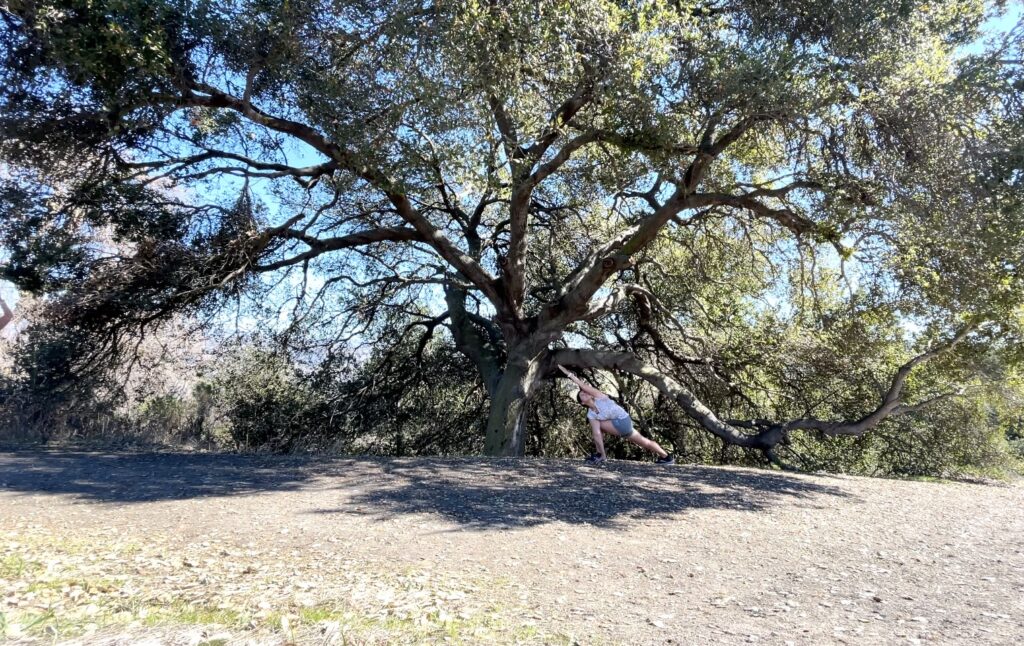
Think back to a time you were young and you did something small which gained a lot of attention. Maybe you drew a picture, tied your shoe, or urinated in the toilet for the first time. It wasn’t as huge of an accomplishment when you think back, but really IT WAS.
“I miss that sensation of a small achievement feeling like a really big deal”. – Gavin DeGraw
As adults, when we set our sights on learning something new, we often forget to celebrate the successes along the way to the end goal. Maybe we have decided that we want to learn the primary series from the Ashtanga Yoga tradition. But each time we step on our mat, we forget what comes next and feel a bit lost. And it’s all too easy to get frustrated with ourselves. I’ve been there.
I even let it keep me from joining the Mysore room because I didn’t know the practice well enough. Yet, that’s where the learning happens. Instead of reaching out to get help, I got down on myself for not being able to do it right. Thank God, I kept trying… and eventually got brave enough to join the room. Once inside, I got kudos for just showing up. Seriously. All I had to do was get there.
I say “all” I had to do but, believe me, I recognize that that is often the hardest part. Even while practicing at home, carving out the time to step onto your mat for practice sometimes takes a tremendous effort. An, YES, even in a pandemic. In fact, maybe even more so. Some newer students of mine recently shared that it is harder to practice virtually in mysore than in a led yoga class (both with video on). At first, I didn’t appreciate the difference. The fact that in a led class, the students are all watching the teacher is the key to this feeling of vulnerability. It takes some time to realize that often, mysore practitioners do not ever look at the computer during their practice. They just listen for the cues and take comfort in the community that breathes along with them.
YOU need to celebrate your successes (big AND small):
Since nobody but the teacher is watching you practice, it is more important than ever to take note of your steps towards the bigger goals. If you grab your big toe instead of your knee in your variation of Utthita Hasta Padangusthasana, that is worth celebrating. If your fingertips touch while trying to catch/bind in Marichyasana C, that is fantastic! Even falling on your face while trying to land your Bakasana B is big. No, it’s HUGE! It means that you generated enough courage to try.
Don’t let these little signs of progress go by unnoticed. Consider keeping a practice journal and write it all down (the good, the bad, and the ugly moments). One day, you’ll be frustrated in yourself while attempting to clasp your wrist in Marichyasana D and may not even remember the first day you were able to catch your fingers in that same pose.
No matter where you are in your yogic journey, there is someone out there who is still mustering the courage to enter the room (virtually or in person). Like the magnificent tree in the photo above, they may look to you for a welcoming smile or encouraging wave. If you can remember when you were in their position, it will be easier to show them the way to enjoy the sweet little moments of joy in the practice – for they matter just as much, if not more, than the bigger successes that come and go.
Mat Manners
By now, you all have probably noticed that practicing at home has its pros and cons. For me, not having to pack up all of my work clothes, lunch, and other items needed for the rest of the day, coupled with not having to navigate the morning commute, is a HUGE plus. Accountability and discipline are a must to keep me coming to my mat day after day. I don’t always feel it, but I do it anyway. When it is all said and done, I am ALWAYS glad that I did.
Connecting to my community via zoom helps as well. After the laptop incident, I don’t dare use my laptop for the connection. Instead, I use my phone. I can’t see everyone at once, but I can hear the breath, voices, and comments while I am on my mat. It’s not the same as being in the room with them, but similar in a way. What I mean is, you aren’t supposed to be looking around, listening in on everyone else’s practice – but knowing you all are in it together in the collective flow is really powerful.
Then, there is my new puppy…
Kobe has been with us for five weeks now. From Day 1, I have made an effort to let him be with me during my practice. To be honest (or frank), I don’t really have a choice. In the beginning, he woke rather early, and had already gotten some rigorous play time before I rolled out my mat. So, usually, he fell back to sleep shortly after my standing poses were complete. Now that he is sleeping through the night, he wakes at the start of Mysore and is fully charged from a full night of sleep. And he wants to PLAY!
Monday being a moon day, I incorporated puppy play into my mini practice. In hind sight, this may have been a mistake. For on Tuesday, he repeatedly brought me the toy I had played tug-o-war with during practice the day before. Only NOW, I didn’t want to play. He and his toy were repeatedly put in my practice space only to be ignored. Young Kobe persisted, tugging on my ponytail, licking my face when I was in the most vulnerable of poses (i.e. kapotasana, supta vajrasana). I struggled, feeling guilty for ignoring him while desperate to not lose my practice.
On Wednesday, I begin again. I am determined to teach my pup some mat manners. He climbs on my mat as soon as I roll it out. “No. No.” I say, picking him up and moving him.
Off the mat.”
It quickly becomes a game. I try to hold both my composure and my ground. A part of me wishes that I wasn’t on zoom for all to see my struggle. The other part of me doesn’t care, confident that my peeps (who are both my peers and my students) don’t care. The practice continues. I use the gate intermittently to create some physical separation (hoping to better illustrate the command). The familiar potty whine comes. We take it outdoors. Then go back inside only to find that Simba (our 9 year old dog) has joined the party.
I am on the verge of tears and just about ready to throw in the towel, when Kobe lies down for a nap. I finish up my practice to get ready for my first meeting of the day…thankful for having not gave up.


